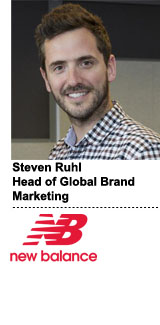
Although athletic apparel manufacturer New Balance makes more than $4 billion in annual revenue in 130-odd markets, it doesn’t share the same name recognition as competitors like Nike, Adidas or Under Armour.
“We found through market research that in most of our markets globally, consumers are aware of us, but they weren’t considering us because they didn’t know how we’re different from other brands,” said Steven Ruhl, global head of brand marketing for New Balance.
So it’s embarking on a year-long digital branding campaign – its first since 2015 – to distinguish its brand and story.
The Boston-based sports apparel brand is 112 years old and began as a manufacturer of arch supports. New Balance wanted to reinforce its position as an independent athletic footwear manufacturer with an emphasis on quality.
New Balance’s brand campaign is leveraging a combination of short-form video on social platforms like Facebook or YouTube, as well as a documentary-style video distributed through Bleacher Report, Vice and Refinery29, featuring New Balance-sponsored athletes.
New Balance hopes to drive a deeper connection with consumers while moving away from purely marketing product, which can become commoditized in such a competitive category.
“To succeed in a category really driven by emotion, we have to really stand for something that’s differentiated and we need to really connect with consumers, and do so in a contemporary or modern way,” Ruhl said.
While New Balance’s marketing team is looking to drive brand equity, it’s also beholden to revenue goals.
In order to meet business goals, it needed a better understanding of the consumer funnel.
“We’re getting a lot more focused on return on investment, driving consumers from the top of the funnel [through to] conversion and ROI,” Ruhl said, adding that the company is becoming more structured in its approach.
Consider its latest branding campaign. Here, long-form video and immersive storytelling drive awareness – an upper-funnel activity.
Short-form video, articles and social content featuring New Brand athletes create engagement in the middle of the funnel.
And the lower funnel – which could include units with more of a hard call to action – are the conversion driver.
“When [you look at] consumers in their teens, 20s or early 30s – they’re not spending that much time engaging with broadcast anymore,” Ruhl said. “How we approach our integrated brand campaigns is to be really rigorous about being social and mobile-first, with a really big focus on distribution-led strategies as well.”
The brand also relies on traditional and offline channels like broadcast and out-of-home to adapt content to local markets abroad, since New Balance has a manufacturing facility in Europe and drives a bulk of its revenue overseas.
This post was syndicated from Ad Exchanger.

More Stories
Meta’s Threads Begins Global Ad Rollout Within Its Feed
Adtech Firm Criteo Is Pitching Hundreds of Retailers on a New Video Ad
2degrees gets loud about NOtifications